The number of farmers' markets nationwide has grown dramatically in the last decade, fueled in part by growing demand for fresh produce. According to the 2002 National Farmers Market Directory, the number of markets increased 79 percent from the 1994 total, to 3,100. 1/
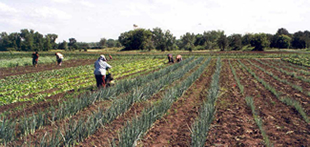 |
New Immigrant Farm Program (NIFP) participants tend a plot of land at the University of Minnesota Outreach, Research and Education (UMORE) Park in Rosemount, Minn. Nearly all of their produce will be sold at area farmers' markets. |
In the Twin Cities, much of the produce sold at these markets is grown by new immigrants who tend plots of land near urban centers. For these immigrants, farming is a source of income, opportunity and independence. However, a number of barriers can prevent new immigrants from accessing land and credit for farming operations. This article outlines some of the benefits and challenges related to farming opportunities for new immigrants. It also examines three programs serving new immigrant farmers in and around the Twin Cities that help these agricultural entrepreneurs obtain the financing and knowledge they need to run a successful farm.
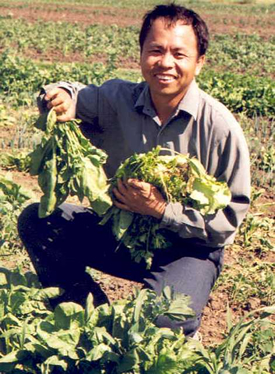 |
NIFP coordinator Vang Yang, a University of Minnesota Extension community program specialist, gathers fresh produce from the fields. |
Money and more
For many new immigrants who settle in urban areas, community gardens provide their first agricultural opportunity in the U.S. According to Corrie Zoll, program director of GreenSpace Partners, a community gardening program administered through the Green Institute in Minneapolis, there are approximately 100 community gardens in Minneapolis alone. These spaces allow new immigrants to produce culturally specific foods and adjust their growing methods to the soil and climate conditions in the Midwest.
Growers who make the transition from community gardens to small-scale farms can earn significant income from even a small plot of land. Vang Yang, community program specialist with University of Minnesota Extension's New Immigrant Farm Program (NIFP), estimates that vegetable growers can earn approximately $4,500 a year per acre, depending on factors such as weather and soil quality.
The benefits of farming go beyond money, according to Nigatu Tadesse, a former extension educator and assistant professor who coordinated the NIFP. "For new immigrants, farming is engraved in their culture," he says, "and sometimes it is therapeutic." As Tadesse explains, farming is a way of life for many families, a link to culturally important foods that are not available in mainstream grocery stores. Growing one's own food provides the opportunity to be one's own boss, become an entrepreneur and gain greater independence.
Barriers to farming
Small-scale farming yields important benefits, but it can be a difficult goal for new immigrants to achieve. The most fundamental element of farming—land—is not easy to acquire. Renting land is an option; however, most immigrants prefer ownership, because land for rent is often difficult to find and renters have limited control over land use. Land ownership is particularly important for farmers who wish to grow organic produce, because the certification process for organic foods requires documentation of any chemicals applied to the land during the previous few years. Purchasing and financing land is a major challenge for new immigrant farmers, because locating affordable land for sale can prove daunting. Many farmers' markets, such as St. Paul's, require that all produce be grown near the central cities, but in the Twin Cities area, land near the central cities is becoming increasingly scarce and commands a premium price.
Even if an affordable plot of land is found, new immigrants may be unfamiliar with the real estate buying process or unaware of the preparation, documentation and business planning that must be performed prior to approaching a lender. Many new immigrants have weak credit histories or no credit histories at all, due to limited exposure to the U.S. credit market. Language barriers can inhibit real estate and financing transactions, and insufficient down-payment ability is another issue.
Lenders may also lack sufficient information on new immigrants' farming businesses, which can weaken applicants' chances of obtaining financing. A lack of familiarity with the products grown by immigrant farmers means lenders must spend additional time researching crop types, probable yields and overall market potential.
New immigrant farmers who succeed in purchasing land can face additional challenges such as a lack of experience with new agricultural techniques. For those who successfully grow crops, finding high-volume sales opportunities can be a challenge. Many of the immigrants who sell at large farmers' markets in the Twin Cities have had their stalls for 10 years or more, limiting the number of open slots for new immigrants.
Programs provide support
Some organizations are recognizing the barriers listed above and offering programs to meet the unique needs of new immigrant farmers. The three programs described below have been effective in providing financing and other support for new immigrant farmers in the Twin Cities area. The first has existed for some time, and the remaining two were created recently.
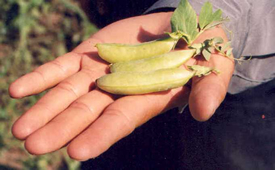 |
Sugar snap peas, one of dozens of crops grown at UMORE Park. |
Farm Service Agency
Charged with providing credit to new farmers and ranchers, the United States Department of Agriculture (USDA) Farm Service Agency (FSA) has been active in Minnesota's new immigrant farmer arena for the past few years. The two loan products available from the FSA include guarantees and direct loans. Guarantees have a combined operating and real estate lending limit of $762,000. Direct loans have a $200,000 limit. They can be used to purchase or improve real estate or to cover operating expenses such as crop inputs; operating debt and purchases of equipment, livestock and farm vehicles.
The FSA works in partnership with conventional lenders, as it is willing to provide guarantees on loans they issue or take a second lien position to a financial institution on real estate loans exceeding $200,000. Because the FSA obtains funding directly from the U.S. Treasury, it is able to offer a rate on its loan products that is slightly below prime. The agency is able to loan up to 100 percent of the securities' market value.
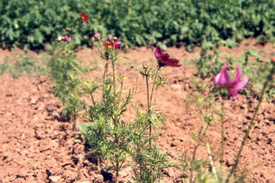 |
In addition to vegetables and herbs, NIFP participants grow a variety of brilliantly colored flowers. |
In 2000, FSA Farm Loan Manager Gregg Bongard successfully issued the first FSA loan to Hmong borrowers. 2/ The loan enabled Der Thao and Nikk Cha to purchase 65 acres in Minnesota's Dakota County, where they grow flowers and Asian vegetables for sale at the St. Paul Farmers Market. In addition to the initial real estate loan, they received subsequent FSA financing for greenhouses, a shed, a well and site improvements. The greenhouses are extremely important, as they lengthen the growing season, opening additional opportunities beyond seasonal farmers' markets.
To expand credit opportunities to other Hmong farmers, Bongard has worked with a number of lenders to increase their knowledge of the types of produce that Hmong farmers typically grow. In one case, Bongard worked closely with a bank to help a borrower obtain a bridge loan that was needed prior to the expiration of a purchase contract. It was the first bridge loan approved for a Hmong farmer in the state of Minnesota. Bongard will soon close direct real estate loans with two other Hmong applicants.
University of Minnesota Extension
Two programs from University of Minnesota Extension (Extension) provide knowledge and intensive technical support to help ensure that new immigrants have access to sustainable small-scale farming opportunities. The programs also help growers connect with farmers' markets throughout the Twin Cities area, acting as intermediaries between growers and market administrators.
Farming Incubator Program. For the past three years, Extension has administered the Farming Incubator Program (FIP), which combines classroom training with hands-on growing experience. Current program participants are immigrants, although Extension Community Program Specialist Yang indicated that the program might be open to nonimmigrants in the future. The primary objectives of the program are: to teach food production jointly with farm management and business planning, give new farmers an opportunity to refine growing techniques and enable new farmers to build equity so they can purchase land when they exit the program.
During the growing season, participants farm one- to three-acre plots. In the winter months, they pursue coursework on a range of topics, including production, processing, business management, record keeping, cash flow, marketing and food safety. Participants pay a minimal amount of tuition, to offset plowing and water costs incurred by the University of Minnesota, and can stay in the program for up to three years. In 2003, the FIP has 39 Hmong, East African and European participants who will farm a total of 100 acres at the University of Minnesota Outreach, Research and Education (U-MORE) Park in Rosemount, Minnesota.
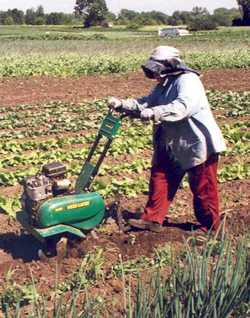 |
An NIFP participant uses a small tilling machine to cultivate a crop row. |
New Immigrant Farm Program. In 1998, Extension launched a program specifically tailored to meet the needs of immigrants who currently rent or lease land across the Twin Cities metro area. The New Immigrant Farm Program (NIFP) provides training and assistance to help these growers increase their productivity.
The program offers culturally appropriate materials in English, Hmong and Spanish on the following topics: integrated pest management, post-harvest handling, marketing and soil fertility management. NIFP workshops feature agricultural experts from the University of Minnesota faculty, USDA's Farm Service and Risk Management Agencies and the Minnesota Department of Agriculture. About 85 percent of the program's current participants are Hmong, and the remaining participants are from East Africa, Europe and Central America.
In addition to offering an educational component, the NIFP helps new immigrants navigate the real estate buying process and will act as an intermediary between land sellers and real estate agents and buyers.
Graduates of the NIFP have successfully gained membership in the St. Paul Farmers Market. The program also established a linkage with the Emergency Food Shelf Network, which will buy directly from growers at U-MORE Park and deliver the produce directly to low-income families. (For more information on the FIP or NIFP, call (651) 423-2413.)
A developing market
New immigrant farmers will continue to face challenges. Barriers to land purchase, financing and marketing persist, and farmers who succeed in overcoming them must meet the additional challenge of opening new markets and increasing the scale of their operations and distribution.
Through financing offered by the FSA and assistance offered by innovative programs like the FIP and NIFP, more and more new immigrant farmers in the Twin Cities area are succeeding. As a result, lenders are becoming increasingly interested in this segment of the market. Some are beginning to develop networks and expertise in the new immigrant agricultural sector. With a growing immigrant population in the Twin Cities, the development of new programs to encourage and support immigrant farming, and increasing attention from lenders, it should be an interesting market to watch.
1/ http://www.ams.usda.gov/farmersmarkets/facts.htm
2/ Schmitz, Rob. Funds to Immigrant Farmers are Cut. Minnesota Public Radio News. Online. August 14, 2002.





